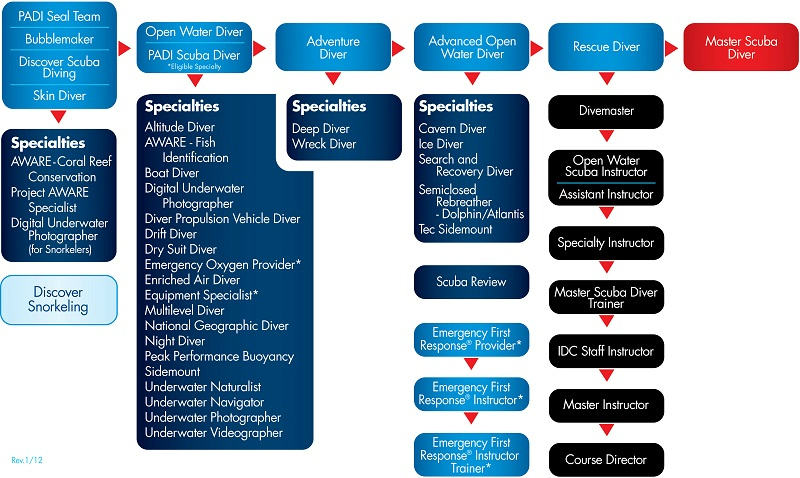Technical Information
- Educational
As a qualified diver you will be required to have a competent and full understanding of all aspects associated with diving. Below is an educational information chart illustration the progression of becoming a qualified scuba diver (as required by PADI). Likewise there are some additional factors that influence all fellow divers.

- Light Underwater
Water absorbs red light, and to a lesser extent, absorbs yellow and green light. In fact, the colour that is least absorbed by water is blue light. The table below illustrates the levels of colour absorption seen in water.
- Absorption Colour Average Wave Length Approximate Depth
Ultraviolet300 nm25 metresViolet400 nm100 metresBlue475 nm275 metresGreen525 nm110 metresYellow575 nm50 metresOrange600 nm20 metresRed685 nm5 metresInfra-red800 nm3 metres
| Absorption Colour | Average Wave Length | Approximate Depth |
| Ultraviolet | 300 nm | 25 metres |
| Violet | 400 nm | 100 metres |
| Blue | 475 nm | 275 metres |
| Green | 525 nm | 110 metres |
| Yellow | 575 nm | 50 metres |
| Orange | 600 nm | 20 metres |
| Red | 685 nm | 5 metres |
| Infra-red | 800 nm | 3 metres |
- Controlling Buoyancy Underwater
Divers must control their rate of descent and ascent in the water if they are to dive safely. A diver’s overall buoyancy determines whether he can ascend or descend efficiently and effectively. Ignoring other forces such as water currents and swimming, a diver’s primary objective is to achieve neutral buoyancy, as this helps minimise gas consumption, enabling the diver to achieve greater diving times and depth if required. Equipment such as diving weighting systems, diving suits (wet, dry or semi-dry, which are used depending on the water temperature) and other buoyancy compensators can be used to adjust the overall buoyancy of a diver.The buoyancy of any object that is immersed in water will also be affected by the density of the water. The density of ocean water for example, is about 3% more than that of fresh water. Therefore, a diver who is neutrally buoyant at one dive destination (a tropical ocean coral reef) will unsurprisingly not be neutrally buoyant at a destination with a different water density (a fresh water lake). It is true to say they will be positively or negatively buoyant.Diving suits, shrink as a diver descends and expand as a diver ascends, thus creating buoyancy changes. Diving in different environments also necessitates adjustments in the amount of weight carried to achieve neutral buoyancy. Weight belts and BCD’s (Buoyancy Control Devices) are used by divers to help compensate for these changes underwater. With the use of a dry suite for example, a diver can inject air into their diving suit to counteract the change in water density and squeeze. Buoyancy compensators allow the necessary adjustments required to achieve correct diver buoyancy.






 (4 votes, average: 4.50 out of 5)
(4 votes, average: 4.50 out of 5)
 (5 votes, average: 3.40 out of 5)
(5 votes, average: 3.40 out of 5)
